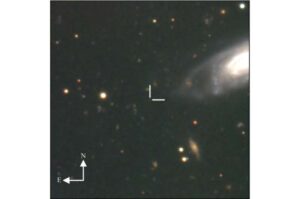
A newly identified super-Earth, located just 20 light-years from our planet, presents a significant opportunity for scientists to explore the potential for extraterrestrial life. Named GJ 251 c, this exoplanet is situated within the habitable zone of its star, where conditions may allow for liquid water to exist, crucial for life as we know it. The discovery was facilitated by advanced spectrographs developed at Penn State University and extensive observations conducted over decades using telescopes globally.
Breakthrough Discovery in Exoplanet Research
The characterization of GJ 251 c as a super-Earth stems from data indicating it has nearly four times the mass of Earth and is likely rocky. According to Suvrath Mahadevan, the Verne M. Willaman Professor of Astronomy at Penn State and co-author of the recent study published in The Astronomical Journal, “We look for these types of planets because they are our best chance at finding life elsewhere.” The planet orbits within the so-called “Goldilocks Zone,” the optimal distance from its star where liquid water could potentially exist if accompanied by the right atmospheric conditions.
The identification of GJ 251 c followed more than 20 years of meticulous observations. Mahadevan noted that the breakthrough arises from a combination of sophisticated tools and a long-term commitment to exoplanet research. The Habitable-Zone Planet Finder (HPF), a high-precision near-infrared spectrograph installed on the Hobby-Eberly Telescope at the McDonald Observatory in Texas, played a crucial role in detecting the planet’s faint signals.
Advanced Techniques Uncover Hidden Signals
Researchers analyzed a vast array of data collected over two decades, focusing on the subtle wobble of the host star, GJ 251, caused by the gravitational influence of orbiting planets. These minute movements appear as slight Doppler shifts in the star’s light spectrum. The team first refined the measurements of a previously known planet, GJ 251 b, which completes an orbit every 14 days. By integrating these long-term observations with new data from the HPF, they detected a stronger signal repeating every 54 days, indicating the presence of a more massive second planet.
Additionally, confirmation of the findings was bolstered by the NEID spectrometer, another instrument developed by Penn State researchers, which operates at the Kitt Peak National Observatory in Arizona. Corey Beard, the corresponding author of the study, emphasized the importance of technological advancements, stating, “We are at the cutting edge of technology and analysis methods with this system.” He highlighted the necessity of community investment in the next generation of telescopes to further explore this promising candidate.
Detecting exoplanets poses challenges, particularly in separating planetary signals from stellar activity, which Mahadevan likened to “stellar weather.” Variations on the star’s surface can mimic the signals produced by orbiting planets, complicating the detection process. The research team employed advanced modeling techniques to differentiate between these signals, demonstrating the complexity of exoplanet discovery.
Future Prospects for Exoplanet Exploration
The collaborative effort behind this discovery showcases the power of multidisciplinary research at Penn State. Eric Ford, a distinguished professor of astronomy and astrophysics at Penn State, noted that mitigating stellar activity noise required not only advanced instrumentation but also tailored data science methods to meet the specific challenges posed by the star in question.
As researchers look forward, Mahadevan expressed optimism about the capabilities of upcoming telescopes, which will be able to examine GJ 251 c’s atmosphere directly. “While we can’t yet confirm the presence of an atmosphere or life on GJ 251 c, the planet represents a promising target for future exploration,” he stated.
The research received support from the U.S. National Science Foundation, NASA, and the Heising-Simons Foundation, underscoring the collaborative nature of scientific inquiry. As the field advances, the potential for discovering evidence of life beyond our solar system becomes increasingly tangible, with GJ 251 c at the forefront of this exciting frontier.






